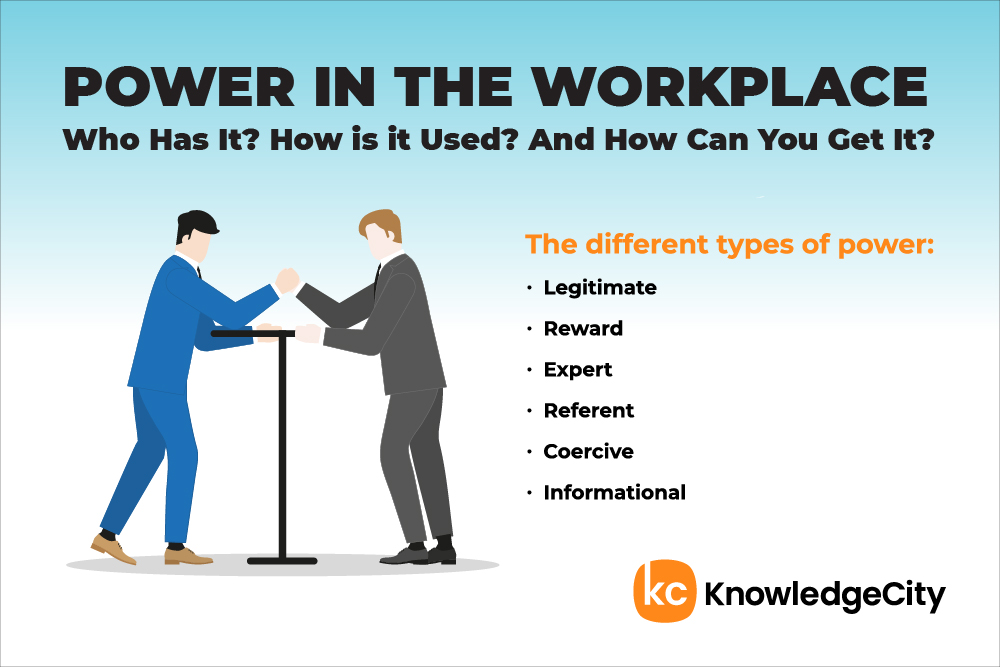Power is arguably one of the most misused and misunderstood concepts in the corporate world. While every organization relies on a defined chain of command to function efficiently, many employees are oblivious to the true nature of power in the workplace and how it can impact their career growth.

What Is Power in the Workplace?
Power is the ability to direct the actions of others or the course of events. A powerful individual is someone with the capacity to influence other people’s behaviors or steer the direction of an organization according to their will.
Those holding key managerial or decision-making positions have power in the workplace. However, the dynamics of workplace relationships, and the mechanisms that propel businesses onward, have created various other types of power. Some of these aren’t easily identifiable.
Types of Power
To know who has power in the workplace, one must first identify the different examples of workplace power and understand how they influence an organization’s growth and development.
In 1959, social psychologists John French and Bertram Raven identified five sources of power. In 1965, Raven identified an additional source. These types of power can determine the degree of influence employees have over each other.
Legitimate Power
Legitimate power is an external type of power that draws its legitimacy from a defined position of authority and demands obedience from all who fall within its sphere of influence.
People who hold this form of power are usually appointed or elected to a position, then lose that authority once they’ve left it.
Managers, supervisors, or anyone occupying a position of authority within the organizational structure all have legitimate power. This allows them to direct their subordinates to comply with their directives.
One key element of legitimate power is that its reach and influence are usually defined and limited to the occupied position. A company’s head of advertising might have the liberty to decide what strategies to use to win customers, but it would be powerless when it comes to paying salaries or hiring new staff.
Reward Power
Reward power is an individual’s ability to offer or deny tangible, social, or emotional benefits to another individual in exchange for performing a specific task. Think of parents giving their children cash gifts or more television time to earn good grades, for instance.
In the workplace, reward-based power is usually expressed when employees receive cash bonuses, promotions, or other similar benefits in recognition of their outstanding performance. However, if a leader has no room in the budget for rewards or gives all the possible awards away, this weakens their power.
Referent Power
Referent power is an internal type of power mostly wielded by likable, charismatic people. Unlike legitimate power, which can be issued through appointment, referent power is a personal ability to impose one’s will on others without legal obligation.
Referent power can be found in employees who naturally pull others closer to themselves. These individuals are natural leaders whom others perceive to be smart and trustworthy. Their excellent interpersonal skills exude confidence and compel others to follow them.
Expert Power
As the name implies, expert power is derived from an individual’s deep technical knowledge and extensive experience in a particular field. It’s one of the few forms of power that anyone can wield once they sharpen their mastery of a particular skill or discipline.
One disadvantage of expert power is that by using it, others will gain it. For example, say you’re a project manager who supervises a team. You train them to properly manage a project, and they continue learning by observing you. As they learn more, your power as the expert will shrink.
While this isn’t a net negative—as your employees are learning and growing more competent—it does mean you’d need to upskill to retain your expert power.
Coercive Power
Coercive power stems from the ability to issue negative consequences for undesired results. Supervisors exercise this power when they punish subordinates for underperforming or failing to show up to work for no concrete reason. Put another way, coercive power is usually perceived as a bullying tactic.
The business community frowns upon coercive power, with researchers conducting studies focused on proving its ineffectiveness as a tool for growth. Coercive power can lower employees’ self-esteem and lead to mental health issues, contributing to workplace burnout.
Informational Power
Informational power refers to the ability to strategically withhold or divulge powerful information. With this type of power, the influence lies in the information’s weight and the holder’s timing when disclosing it.
To consistently wield this kind of power, a person needs to be in a position that’s privy to sensitive or impactful information. They also need to know the best time to divulge the information.
This delicate form of power can hurt the holder and bring about unforeseen or undesired consequences, depending on how it’s handled. For instance, sharing classified news about an impending wage cut could endear an individual to their colleagues and expose them to punitive actions by company management.
Also, once someone divulges the information, they lose that power.
Who Has Power in the Workplace?
The short answer: everyone. Regardless of their position, every employee holds some power and uniquely impacts the business’s growth.
However, what separates the truly powerful people in the organization from the rest is their degree of influence. Based on this, people with power in the workplace can be divided into two categories.
Bestowed Power
Bestowed power refers to all kinds of power given to an individual by appointment or delegation. Those with legitimate, coercive, and reward power usually fall under this category.
This group of power holders is a pivotal link in an organizational hierarchy, starting from the top executives—who are likely to be the ones bestowing the power—down to the regular staff. A CEO and a security guard in charge of opening and locking the office can both be said to hold bestowed power.
One unique feature of bestowed power is that it can easily and instantly be transferred from one person to another.
Earned Power
Earned power is derived from an employee’s expertise or unusual abilities. It refers to the kind of influence an individual receives for being so exceptional at certain tasks that they become recognized as an authority figure. Referent and expert power naturally fall under this category as they must be cultivated by the individuals seeking to wield them.
While bestowed power is constant and vested in the holder’s position and can be transferred at will, earned power is situational and vested in the individual occupying the position.
The Implications of Power in the Workplace
The truth about power is that it exists whenever there’s a relationship between two or more people, regardless of formal hierarchies and titles. On its own, power is neither a positive nor a negative trait. The method of application and reason for use determines whether it’s good or bad.
In the workplace, those with legitimate power have a contractual obligation to use it to aid their company’s growth and development. How they choose to exercise their powers can shape the dynamics of their organizations and determine how much employees become vested in advancing their goals and objectives.
Knowing when to use different types of power separates top-performing managers from the rest. A proper understanding and mastery of power dynamics can help leaders positively impact their employees’ morale and productivity.
How to Harness Power in the Workplace
A clearly defined flow of authority is necessary for any organization that wants to excel. There are many benefits to properly using power, including improving both communication and collaboration, as well as improving culture and equity between employees.
Here’s a detailed strategy anyone can employ to harness their power and use it for good in the workplace.
Step 1: Evaluate the Status Quo
Anyone seeking to harness power for good must first evaluate the status quo at work to determine their level of influence. This person must figure out how many types of power they currently possess and the degree to which they possess them.
Step 2: Determine the Limits
Determine what the limits of those powers are. For example, knowing the limits of one’s expert power will enable that person to operate better only in areas where control is guaranteed. It will also prevent them from overstepping their boundaries, helping them avoid clashes with other authority holders within the organization.
Step 3: Set Goals
Then, they must spell out the specific goals and objectives they want to accomplish with their defined authority. For instance, a supervisor with reward power can decide to motivate those under their authority with desirable incentives that would boost productivity and make their department stand out from the rest.
Step 4: Identify Strategies
The types of power have different strengths, so they require different modes of execution. To fully optimize one’s influence, the individual must adopt a strategy that efficiently combines all their strengths to achieve their desired goal.
One strategy could be combining the benefits of reward power with the obligation of legitimate power. This would create incentives for employees to increase productivity. A different manager may add coercive power to the mix, punishing those who fall behind.
Others with referent power can indirectly impose their will by giving advice or offering encouragement to boost morale and get the whole team back on track.
Step 5: Evaluate Outcomes
The final step involves reviewing the implemented strategies and measuring their effectiveness based on the outcome. This involves measuring both success and failure.
If the goals were achieved, then the individual should analyze how each chosen strategy contributed to producing the desired results. If some or all the goals weren’t realized, emphasis should be placed on analyzing the efforts to identify lapses and areas that require improvement.
Understanding the dynamics of power in the workplace is vital for those seeking to exert their influence in any organization. The true test of an effective leader lies in their ability to rely on the various types of power in different situations. Discretion is a valuable ally when exercising power, and good leaders know when the situation demands that they do nothing.
To properly navigate the dynamics of power in the workplace, one must develop a deep understanding of the people working in the organization. Knowing their strengths, weaknesses, fears, and aspirations will provide a blueprint for the best ways to interact with and influence them.
Harnessing and keeping power is a skill that requires patience and practice. Anyone seeking to become a more influential leader must devote time to it and learn from their mistakes.
Healthy power dynamics improve the interpersonal relationships between employees at all organizational levels, creating a harmonious environment that allows for growth.
Subscribe to Our Newsletter
Join 80,000+ Fellow HR Professionals. Get expert recruiting and training tips straight
to your inbox, and become a better HR manager.

 KnowledgeCity
KnowledgeCity 











